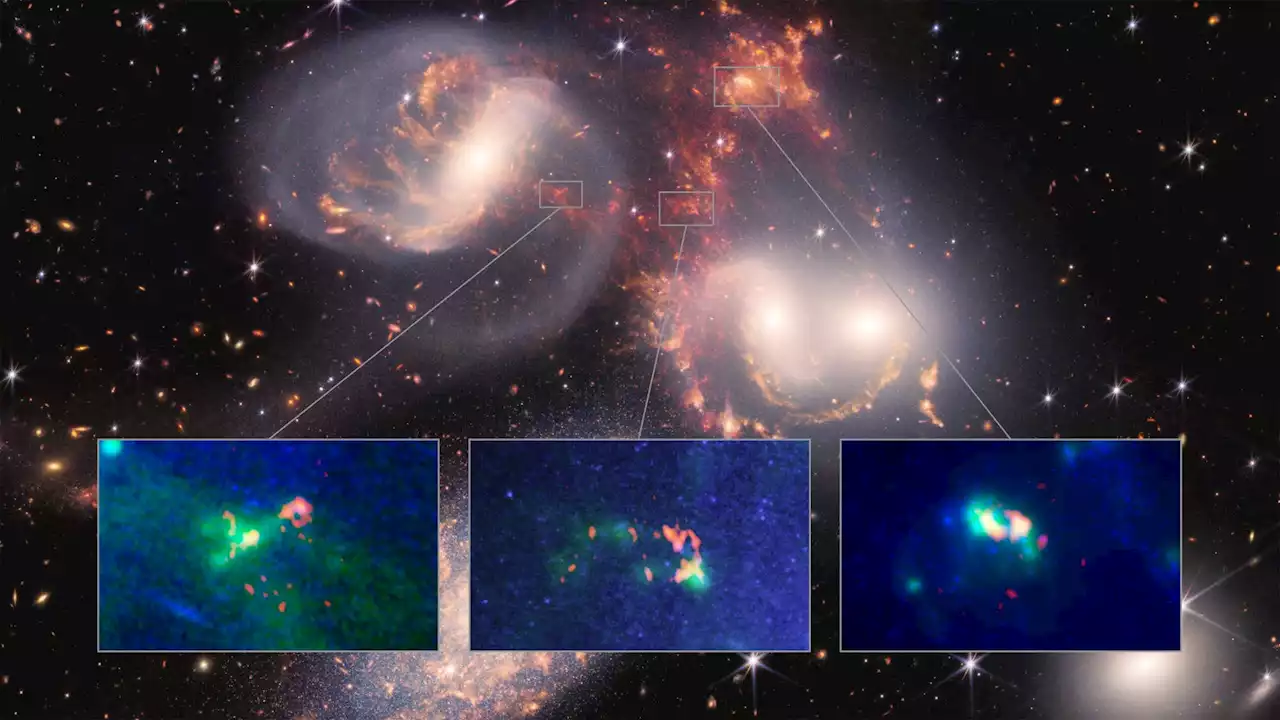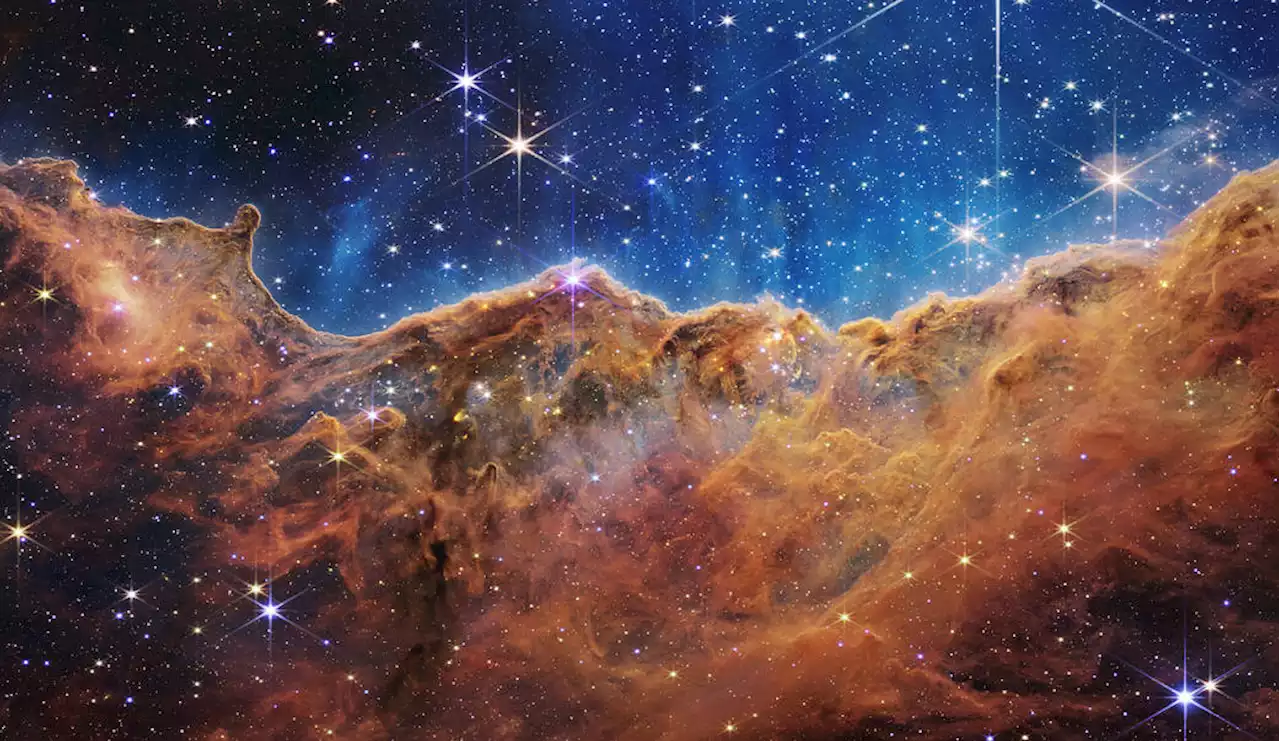New reports from James Webb indicate that a massive shockwave rippled through Stephan's Quintet and could mark the birth of a new galaxy.
first James Webb images
that marked the brand-new telescope’s first observations. Now, the quintet is at the center of Webb’s observations as it spied a shockwave barreling through the collective. The Atacama Large Millimeter/submillimeter Array has also been at the center of the new observations. The shockwave, which Webb astronomers attribute to the collision of an intruder galaxy known as NGC 731b with Stephan’s Quintet. The new galaxy has been forcing its way into the quintet at a relative speed of around 1.8 million MPH . At this speed, the galaxy could travel from Earth to the moon and back in a little over 15 minutes.
The collision between NGC 731b and Stephan’s Quintet has given birth to this new shockwave, though, which Webb observed moving at over one million miles per hour. The invasion of the quintet by this intruder galaxy has caused a rippling through the interstellar plasma of the galaxies, kicking up warm and cold molecular hydrogen gas amidst the quintet.This “recycling plant” of gases has been seen forming a giant cloud of gas that has since begun to break apart into a more fog-like appearance.
The importance of the data gathered from Webb observing this shockwave could have massive implications, too.
United States Latest News, United States Headlines
Similar News:You can also read news stories similar to this one that we have collected from other news sources.
 James Webb Space Telescope spies massive shockwave and baby dwarf galaxy in Stephan's QuintetA shockwave traveling through Stephan's Quintet at over a million miles per hour is causing turbulence in between its five galaxies.
James Webb Space Telescope spies massive shockwave and baby dwarf galaxy in Stephan's QuintetA shockwave traveling through Stephan's Quintet at over a million miles per hour is causing turbulence in between its five galaxies.
Read more »
 James Webb Space Telescope Looks Back Into the Early Universe, Sees Galaxies Like Our Milky WayNew images from NASA’s James Webb Space Telescope (JWST) reveal for the first time galaxies with stellar bars — elongated features of stars stretching from the centers of galaxies into their outer disks — at a time when the universe was a mere 25% of its present age. The finding of so-called barred
James Webb Space Telescope Looks Back Into the Early Universe, Sees Galaxies Like Our Milky WayNew images from NASA’s James Webb Space Telescope (JWST) reveal for the first time galaxies with stellar bars — elongated features of stars stretching from the centers of galaxies into their outer disks — at a time when the universe was a mere 25% of its present age. The finding of so-called barred
Read more »
 James Webb Space Telescope detects a sonic boom bigger than Milky WayObservations made with JWST and ALMA allowed researchers to see the complex interactions within the multi-galaxy collision event known as Stephan's Quintet
James Webb Space Telescope detects a sonic boom bigger than Milky WayObservations made with JWST and ALMA allowed researchers to see the complex interactions within the multi-galaxy collision event known as Stephan's Quintet
Read more »
 Early James Webb Space Telescope findings take center stage at key astronomy conferenceSharmila is a Seattle-based science journalist. She found her love for astronomy in Carl Sagan's The Pale Blue Dot and has been hooked ever since. She holds an MA in Journalism from Northeastern University and has been a contributing writer for Astronomy Magazine since 2017. Follow her on Twitter at Sharmilakg.
Early James Webb Space Telescope findings take center stage at key astronomy conferenceSharmila is a Seattle-based science journalist. She found her love for astronomy in Carl Sagan's The Pale Blue Dot and has been hooked ever since. She holds an MA in Journalism from Northeastern University and has been a contributing writer for Astronomy Magazine since 2017. Follow her on Twitter at Sharmilakg.
Read more »
 SXSW Brings the Cosmos to AustinSXSW announces Nick Jonas, KIller Mike, and unseen images from the James Webb telescope.
SXSW Brings the Cosmos to AustinSXSW announces Nick Jonas, KIller Mike, and unseen images from the James Webb telescope.
Read more »
 ALMA and JWST reveal galactic shock is shaping Stephan's Quintet in mysterious waysShockwaves resulting from the violent collision between an intruder galaxy and Stephan's Quintet are helping astronomers to understand how turbulence influences gas in the intergalactic medium.
ALMA and JWST reveal galactic shock is shaping Stephan's Quintet in mysterious waysShockwaves resulting from the violent collision between an intruder galaxy and Stephan's Quintet are helping astronomers to understand how turbulence influences gas in the intergalactic medium.
Read more »
